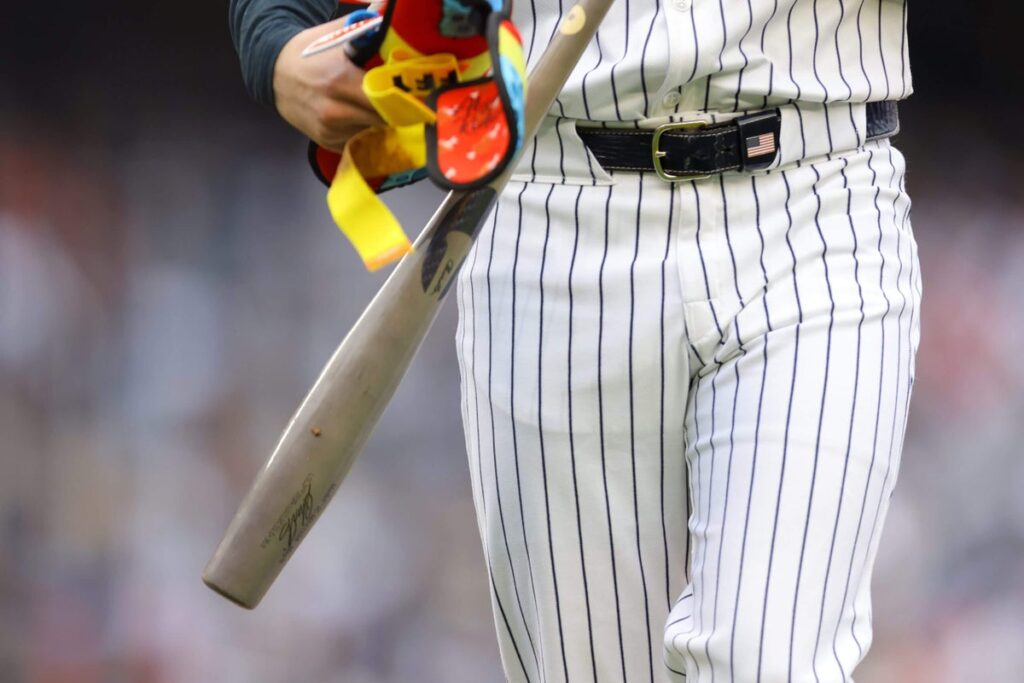
In a remarkable turn of events, the New York Yankees have captured the attention of Major League Baseball with their recent power surge against the Milwaukee Brewers, driven in part by an innovative new bat design. Over the weekend, the Yankees shattered records, hitting a franchise-record nine home runs in a single game, and the buzz around “torpedo bats” has been growing ever since.
The spotlight on these bats intensified when YES Network announcer Michael Kay revealed during the broadcast that the Yankees had been experimenting with bats featuring a reimagined design. Developed by a former team employee and MIT physicist, these bats shift more wood into the label area, creating a shape reminiscent of a torpedo. This adjustment aims to enhance contact and increase the number of “barrels” a hitter can achieve.
The Science Behind the Surge
The Yankees’ front office had been analyzing player performance, particularly focusing on Anthony Volpe’s at-bats. They discovered that Volpe was making more contact slightly below the barrel, prompting the development of these new bats. As Kay explained, “the harder part of the bat is actually going to strike the ball,” potentially leading to greater power and precision.
The results were immediate and impressive. The Yankees’ 20-9 victory over the Brewers was followed by another dominant performance, with New York hitting four more home runs to complete a three-game sweep. Their 15 home runs in three games tied an MLB record, leaving many to wonder whether the torpedo bats were the catalyst.
League-Wide Curiosity and Adoption
The Yankees’ success with the torpedo bats has not gone unnoticed across the league. Players and teams are increasingly curious about the potential benefits of this new equipment. Los Angeles Angels infielder Nicky Lopez noted that the bats were already in use during spring training with the Chicago Cubs. “It seems like it’s making its way around MLB,” Lopez commented, highlighting the growing interest.
Multiple teams, including the Minnesota Twins, Toronto Blue Jays, and Tampa Bay Rays, have players experimenting with the torpedo bats. The Boston Red Sox, while aware of the bats, have yet to adopt them in regular-season play. However, the Cubs have been researching these bats since last season, with reports suggesting they may increase exit velocity.
“It will get plenty of attention now,” said Detroit Tigers manager A.J. Hinch. “The internet has a beautiful way of bringing things to be a big deal.”
Historical Context and Future Implications
The concept of the torpedo bat is not entirely new. Aaron Leanhardt, the MIT physicist responsible for the design, began developing these bats around 2022 while working with the Yankees. Initially introduced to minor league players, the bats were not an immediate hit. However, Leanhardt’s persistence in promoting the benefits of increased contact and reduced swing-and-miss rates has gradually gained traction.
As the torpedo bats gain popularity, questions arise about their impact on the game. Some traditionalists, like Angels manager Ron Washington, express skepticism, preferring to rely on skill development rather than equipment changes. Yet, the legality of the bats under MLB rules ensures that they remain a viable option for players seeking an edge.
“I think it’s really smart,” said Angels outfielder Taylor Ward. “It makes sense, where guys constantly hit the ball on the bat. I think it’s an amazing discovery.”
The Road Ahead for Torpedo Bats
As more players experiment with torpedo bats, their influence on the game could grow. Jazz Chisholm Jr. of the Miami Marlins has already embraced the new design, citing increased confidence at the plate. “It gives you that extra confidence in your head to go out there and hit anything,” Chisholm remarked after hitting two home runs with the bat.
While the torpedo bat may not suit every player, its potential to revolutionize hitting strategies cannot be ignored. As the MLB community continues to explore this innovation, the future of the torpedo bat remains uncertain but promising. Whether it becomes a staple in the league or a passing trend, its impact on the game has already begun to unfold.
— The Athletic’s Cody Stavenhagen, David O’Brien, Matt Gelb, Jen McCaffrey, Dan Hayes, Sahadev Sharma, Britt Ghiroli, and Dennis Lin contributed reporting to this story.






